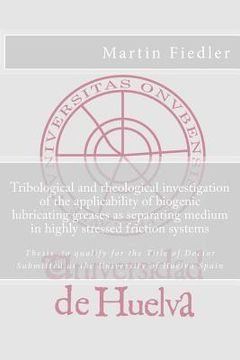Share
Tribological and rheological investigation of the applicability of biogenic lubricating greases as separating medium in highly stressed friction syste (in English)
Martin Fiedler
(Author)
·
Createspace Independent Publishing Platform
· Paperback
Tribological and rheological investigation of the applicability of biogenic lubricating greases as separating medium in highly stressed friction syste (in English) - Fiedler, Martin
$ 6.49
$ 8.23
You save: $ 1.74
Choose the list to add your product or create one New List
✓ Product added successfully to the Wishlist.
Go to My WishlistsIt will be shipped from our warehouse between
Monday, May 27 and
Tuesday, May 28.
You will receive it anywhere in United States between 1 and 3 business days after shipment.
Synopsis "Tribological and rheological investigation of the applicability of biogenic lubricating greases as separating medium in highly stressed friction syste (in English)"
There is a growing demand of environmentally friendly lubricating greases that presently can only be satisfied partially. The purpose of this work is to fundamentally investigate the effects that grease components exert on the resulting rheological and tribological characteristics. A limited number of different components-that is four different base oils and four structurally different thickener systems-were selected, which qualify these greases as bio-lubricants. All sixteen greases were formulated at identical NLGI grades to eliminate the consistency's influence on the results. These greases then underwent a series of tribological experiments on a nano tribometer test rig with the application of four different normal forces and two different material combinations resulting in individual sets of Hertzian stresses. Additionally, atomic force microscopy observations of all model greases were carried out to give evidence to their micro structural setup. The model greases were also rheologically investigated under different deformation situations. On the one hand, the flow response in transient shear was monitored in rotational tests, on the other hand, the greases were rheologically characterized by both, the frequency and amplitude dependent responses in small-amplitude oscillatory shear. All thus found results were also evaluated from an energetic pointof view. In addition, a series of rather unconventional test were performed with the model greases. These were tensile tests with a plate-plate rheometer where a defined gap was filled with grease and then subjected to a separation of the plates while logging the normal force and bouncing ball tests where a steel ball hit a grease-covered steel plate after having fallen a preset distance. In latter tests the resulting bouncing hight, the length of the drawn grease string as well as the impact mark were investigated. The main findings of this work are based on influences that the different base oil polarities exerted on the tribological as well as the rheological grease characteristics. For one thing, they were revealed in the type, severity and extent of wear marks produced in the contacting surfaces of tribological tests. Here it was shown that these base oil polarity influences highly depend on the applied thickener system and the investigated material combination. It has even shown that polarity influences can be also significantly dampened depending on the material combination. For another thing, polarity influences were detected in the outcome of the rheological grease investigation. Here it was shown that the extend with which they come to act highly depends on the employed thickener system. It has also shown that the base oil polarity influenced the percentage thickener share depending on the type of thickener system. In the transient shear flow tests an attempt has been made to eliminate the rheological results from this thickener percentage. This is done by the evaluation of the activation energy, necessary for the structural thickener degradation revealing a large difference between greases based on highly polar oils and those based on low-polarity oils. It is shown that this effect also highly depends on the applied thickener type. This work is concluded by a disquisition of effects that help to elucidate the working mechanisms in the lubricated grease contact and which evoke individual wear results in all grease systems and material combinations. One of these effects pertains to the mechanisms that come to act with different base oil polarities and the direct influence they exert on wear results. The other effect highlights the mechanisms that come to act in the internal grease structure which has been elucidated by rheometric assessment. It is also shown that these two effects influence each other.
- 0% (0)
- 0% (0)
- 0% (0)
- 0% (0)
- 0% (0)
All books in our catalog are Original.
The book is written in English.
The binding of this edition is Paperback.
✓ Producto agregado correctamente al carro, Ir a Pagar.

